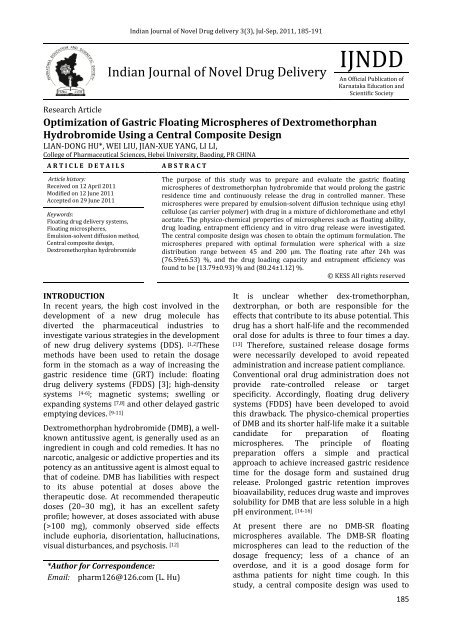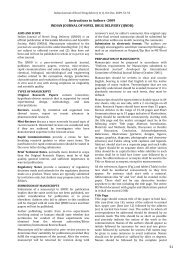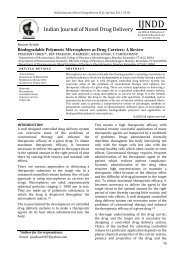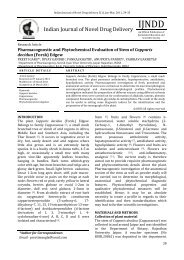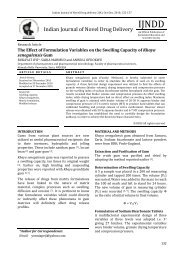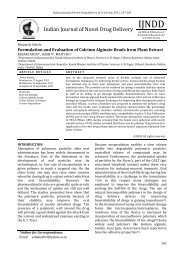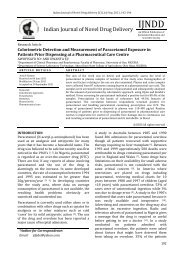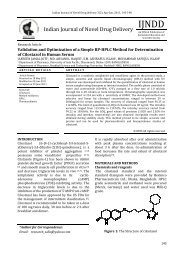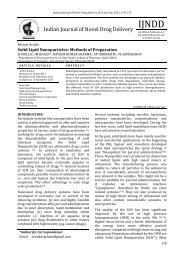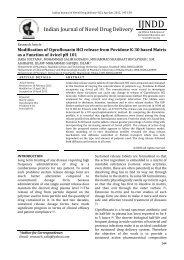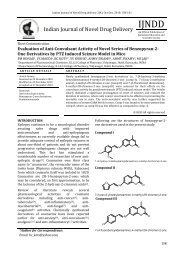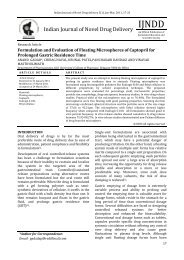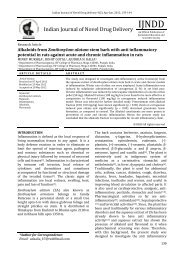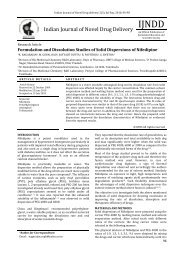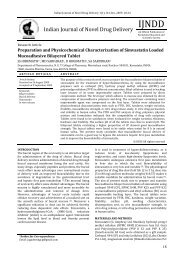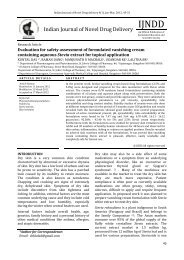Optimization of Gastric Floating Microspheres of Dextromethorphan ...
Optimization of Gastric Floating Microspheres of Dextromethorphan ...
Optimization of Gastric Floating Microspheres of Dextromethorphan ...
You also want an ePaper? Increase the reach of your titles
YUMPU automatically turns print PDFs into web optimized ePapers that Google loves.
Indian Journal <strong>of</strong> Novel Drug delivery 3(3), Jul-Sep, 2011, 185-191<br />
Indian Journal <strong>of</strong> Novel Drug Delivery<br />
IJNDD<br />
An Official Publication <strong>of</strong><br />
Karnataka Education and<br />
Scientific Society<br />
Research Article<br />
<strong>Optimization</strong> <strong>of</strong> <strong>Gastric</strong> <strong>Floating</strong> <strong>Microspheres</strong> <strong>of</strong> <strong>Dextromethorphan</strong><br />
Hydrobromide Using a Central Composite Design<br />
LIAN-DONG HU*, WEI LIU, JIAN-XUE YANG, LI LI,<br />
College <strong>of</strong> Pharmaceutical Sciences, Hebei University, Baoding, PR CHINA<br />
A R T I C L E D E T A I L S<br />
A B S T R A C T<br />
Article history:<br />
Received on 12 April 2011<br />
Modified on 12 June 2011<br />
Accepted on 29 June 2011<br />
Keywords:<br />
<strong>Floating</strong> drug delivery systems,<br />
<strong>Floating</strong> microspheres,<br />
Emulsion-solvent diffusion method,<br />
Central composite design,<br />
<strong>Dextromethorphan</strong> hydrobromide<br />
The purpose <strong>of</strong> this study was to prepare and evaluate the gastric floating<br />
microspheres <strong>of</strong> dextromethorphan hydrobromide that would prolong the gastric<br />
residence time and continuously release the drug in controlled manner. These<br />
microspheres were prepared by emulsion-solvent diffusion technique using ethyl<br />
cellulose (as carrier polymer) with drug in a mixture <strong>of</strong> dichloromethane and ethyl<br />
acetate. The physico-chemical properties <strong>of</strong> microspheres such as floating ability,<br />
drug loading, entrapment efficiency and in vitro drug release were investigated.<br />
The central composite design was chosen to obtain the optimum formulation. The<br />
microspheres prepared with optimal formulation were spherical with a size<br />
distribution range between 45 and 200 μm. The floating rate after 24h was<br />
(76.59±6.53) %, and the drug loading capacity and entrapment efficiency was<br />
found to be (13.79±0.93) % and (80.24±1.12) %.<br />
© KESS All rights reserved<br />
INTRODUCTION<br />
In recent years, the high cost involved in the<br />
development <strong>of</strong> a new drug molecule has<br />
diverted the pharmaceutical industries to<br />
investigate various strategies in the development<br />
<strong>of</strong> new drug delivery systems (DDS). [1,2] These<br />
methods have been used to retain the dosage<br />
form in the stomach as a way <strong>of</strong> increasing the<br />
gastric residence time (GRT) include: floating<br />
drug delivery systems (FDDS) [3]; high-density<br />
systems [4-6]; magnetic systems; swelling or<br />
expanding systems [7,8] and other delayed gastric<br />
emptying devices. [9-11]<br />
<strong>Dextromethorphan</strong> hydrobromide (DMB), a wellknown<br />
antitussive agent, is generally used as an<br />
ingredient in cough and cold remedies. It has no<br />
narcotic, analgesic or addictive properties and its<br />
potency as an antitussive agent is almost equal to<br />
that <strong>of</strong> codeine. DMB has liabilities with respect<br />
to its abuse potential at doses above the<br />
therapeutic dose. At recommended therapeutic<br />
doses (20–30 mg), it has an excellent safety<br />
pr<strong>of</strong>ile; however, at doses associated with abuse<br />
(>100 mg), commonly observed side effects<br />
include euphoria, disorientation, hallucinations,<br />
visual disturbances, and psychosis. [12]<br />
*Author for Correspondence:<br />
Email: pharm126@126.com (L. Hu)<br />
It is unclear whether dex-tromethorphan,<br />
dextrorphan, or both are responsible for the<br />
effects that contribute to its abuse potential. This<br />
drug has a short half-life and the recommended<br />
oral dose for adults is three to four times a day.<br />
[13] Therefore, sustained release dosage forms<br />
were necessarily developed to avoid repeated<br />
administration and increase patient compliance.<br />
Conventional oral drug administration does not<br />
provide rate-controlled release or target<br />
specificity. Accordingly, floating drug delivery<br />
systems (FDDS) have been developed to avoid<br />
this drawback. The physico-chemical properties<br />
<strong>of</strong> DMB and its shorter half-life make it a suitable<br />
candidate for preparation <strong>of</strong> floating<br />
microspheres. The principle <strong>of</strong> floating<br />
preparation <strong>of</strong>fers a simple and practical<br />
approach to achieve increased gastric residence<br />
time for the dosage form and sustained drug<br />
release. Prolonged gastric retention improves<br />
bioavailability, reduces drug waste and improves<br />
solubility for DMB that are less soluble in a high<br />
pH environment. [14-16]<br />
At present there are no DMB-SR floating<br />
microspheres available. The DMB-SR floating<br />
microspheres can lead to the reduction <strong>of</strong> the<br />
dosage frequency; less <strong>of</strong> a chance <strong>of</strong> an<br />
overdose, and it is a good dosage form for<br />
asthma patients for night time cough. In this<br />
study, a central composite design was used to<br />
185
Lian-Dong Hu et al / Indian Journal <strong>of</strong> Novel Drug Delivery 3(3),Jul-Sep, 2011, 185-191<br />
optimize the preparation <strong>of</strong> DMB floating<br />
microspheres. The concentration <strong>of</strong> poloxamer<br />
188, the concentration <strong>of</strong> EC and the theoretical<br />
drug content were selected as independent<br />
variables while the entrapment efficiency,<br />
buoyancy, drug loading, and drug release after<br />
24 hours as the dependent variables. Then the<br />
particle size, scanning electron microscopy, drug<br />
loading and entrapment efficiency, in vitro<br />
buoyancy and release characteristics study <strong>of</strong> the<br />
prepared floating microspheres were<br />
investigated.<br />
MATERIALS AND METHODS<br />
Materials<br />
DMB as reference substances were supplied by<br />
National Institute for the Control <strong>of</strong><br />
Pharmaceutical and Biological Products. DMB as<br />
the model drug was purchased from Shanghai<br />
Dingkang Pharmaceutical Co., Ltd. α-Asarone was<br />
provided from National Institute for the Control<br />
<strong>of</strong> Pharmaceutical and Biological Products. Ethyl<br />
cellulose (EC, 7 cps) was provided from Shanghai<br />
Colorcon Co. Ltd. Poloxamer 188 and cetyl<br />
alcohol were provided by Shang Hai Xie Tai<br />
Chemical Industry Co. Ltd. Acetonitrile (HPLC<br />
grade) was obtained from Tianjin Kermel<br />
Chemical Reagent Co. Ltd. All other reagents<br />
were <strong>of</strong> analytical grade.<br />
Preparation <strong>of</strong> microspheres<br />
These microspheres were prepared by emulsionsolvent<br />
diffusion technique. DMB, ethyl cellulose<br />
and cetyl alcohol were dissolved in a mixture <strong>of</strong><br />
dichloromethane and ethyl acetate (7:3, v/v) at<br />
room temperature. This was slowly added to 100<br />
ml water containing poloxamer 188 maintained<br />
at a temperature <strong>of</strong> 30–40°C and subsequently<br />
stirred at ranging agitation speed for 20 min to<br />
allow the volatile solvent to evaporate. The<br />
microspheres were collected, washed with<br />
distilled water and oven-dried (40°C).<br />
Experiments design<br />
As the basis <strong>of</strong> preliminary experiment, the<br />
central composite design (CCD) was selected for<br />
the optimization <strong>of</strong> the parameters. The chosen<br />
independent factors, i.e. the concentration <strong>of</strong><br />
poloxamer 188(X 1), the concentration <strong>of</strong> EC (X 2)<br />
and the theoretical drug content(X 3), have more<br />
significant effects on the property <strong>of</strong><br />
microspheres. The three independent variables<br />
and their levels are listed in Table 1. The<br />
entrapment efficiency, drug loading, drug release<br />
after 24 hours (F 24h), and particle size were kept<br />
as dependent variables. A second-order<br />
polynomial model was used to generate response<br />
surfaces:<br />
Y=B 0+B 1X 1+B 2X 2+B 3X 3+B 12X 1X 2+B 13X 1X 3+B 23X 2X 3<br />
+B 11X 1<br />
2+B 22X 2<br />
2+B 33X 3<br />
2<br />
where Y is the measured response associated<br />
with each factor level combination; B 0 is an<br />
intercept; B 1 to B 33 are regression coefficients;<br />
and X 1, X 2 and X 3 are the independent variables.<br />
The dependent and independent variables<br />
selected are presented in Table 1 along with<br />
their low, medium and high levels selected for<br />
the study.<br />
Table 1: Experimental design <strong>of</strong> level and factor<br />
Level X1 X2 X3<br />
- 1.732<br />
- 1<br />
0<br />
+ 1<br />
+ 1.732<br />
0.5<br />
1.35<br />
2.5<br />
3.65<br />
4.5<br />
10<br />
12.11<br />
15<br />
17.89<br />
20<br />
10<br />
14.23<br />
20<br />
25.77<br />
30<br />
Scanning electron microscopy<br />
Scanning electron microscopy (SEM) (KYKY<br />
Technology Development LTD. Beijing, China)<br />
studies were performed to characterize the<br />
surface <strong>of</strong> formed microspheres. Before<br />
scanning, the microspheres were sputtered with<br />
gold to make the surface conductive.<br />
Determination <strong>of</strong> drug loading and<br />
entrapment efficiency<br />
The samples were determined using the HPLC<br />
method. The HPLC system consisted <strong>of</strong> a P3000A<br />
pump and a UV detector. A Venusil XBP C18<br />
column (5 μm, 250 × 4.6 mm) was used. The<br />
mobile phase consisted <strong>of</strong> 0.5% triethylamine<br />
(pH 3.5 adjusted by phosphoric acid)-acetonitrile<br />
(75:25,v/v), The flow rate was 1.0 ml·min -1 ,<br />
and the UV detector was set at 278 nm.<br />
A certain amount <strong>of</strong> microspheres were ground<br />
to powder. Then the powder containing<br />
approximately 10 mg drug was weighed and<br />
added to a 100 ml volumetric flask containing 70<br />
ml <strong>of</strong> mobile phase. After 20 min <strong>of</strong> ultrasonic<br />
extraction, the sample was diluted with mobile<br />
phase to 100 ml and then filtered through a 0.45<br />
µm membrane. 20 µl <strong>of</strong> the filtered solution was<br />
injected for analysis. All samples were analyzed<br />
in triplicate. The drug loading (DL) and<br />
entrapment efficiency (EE) were calculated as<br />
follows:<br />
186
Lian-Dong Hu et al / Indian Journal <strong>of</strong> Novel Drug Delivery 3(3),Jul-Sep, 2011, 185-191<br />
W D<br />
DL (%) = ×100<br />
WT<br />
W D: the weight <strong>of</strong> the drug loaded in the<br />
microspheres; W T: the total weight <strong>of</strong> the<br />
microspheres.<br />
W A<br />
EE (%) = ×100<br />
WT<br />
W A: actual drug content; W T: theoretical drug<br />
content.<br />
In vitro evaluation <strong>of</strong> floating ability<br />
The floating test was performed to investigate<br />
the floatability <strong>of</strong> the prepared microspheres.<br />
The microspheres (0.1g) were spreaded on 500<br />
ml <strong>of</strong> 0.1 mol/L HCl containing 0.02% Tween 80<br />
as surfactant to simulate gastric conditions. The<br />
mixture was stirred with a paddle at 100 rpm,<br />
temperature was maintained at 37±0.5°C.12h<br />
later, the floating and the settled portions <strong>of</strong><br />
microspheres were recovered separately. The<br />
microspheres were dried and weighed. The<br />
buoyancy was calculated as the following<br />
equation:<br />
Qf<br />
Buoyancy (%) = ×100<br />
Qf<br />
+ Qs<br />
Q f: weights <strong>of</strong> the floating microspheres;<br />
Q s: weights <strong>of</strong> the settled microspheres.<br />
In vitro release studies<br />
The in vitro release studies were performed in<br />
250ml <strong>of</strong> artificial gastric fluid (pH 1.2)<br />
thermostatically maintained at 37 ± 0.5°C based<br />
on Chinese Pharmacopoeia (2005 Ed.) Method<br />
Ⅲ. Paddle rotational speed was set to 50 rpm. 5<br />
ml samples were withdrawn and replaced with<br />
an equal volume <strong>of</strong> the same fresh medium at<br />
predetermined time intervals. The sample<br />
solutions were filtered through a 0.45 µm<br />
membrane and analyzed using a UV<br />
spectrophotometer at 278 nm.<br />
RESULTS AND DISCUSSION<br />
Experimental design<br />
Central composite design results<br />
For a three-factor central composite design, 20<br />
experiments are required and the results <strong>of</strong><br />
entrapment efficiency, drug loading, drug release<br />
after 24 hours (F 24h), and drug loading are shown<br />
in Table 2. Experiments l-8 represent the simple<br />
factorial design using two levels <strong>of</strong> each variable.<br />
Experiments 9-14 are the star points and<br />
experiments 15-20 represent the central point.<br />
Data evaluation<br />
The entrapment efficiency, drug loading,<br />
buoyancy and F 24h (drug release after 24 hours)<br />
were selected as the dependent variables. The<br />
equations by a second-order polynomial model<br />
were shown as follow, and then the threedimensional<br />
response surface graphs fitted to<br />
the equation were shown in Figure 1. (The<br />
concentration <strong>of</strong> EC (X 2) was held at 15%<br />
because <strong>of</strong> its insignificant influence compared<br />
with X 1 and X 3.)<br />
The model equation for DL:<br />
DL/%=-0.541+1.038X 1-<br />
0.305X 2+0.991X 3+0.029X 1<br />
2<br />
+0.009X 2<br />
2-0.020X 3<br />
2-0.076X 1X 2-0.029X 1X 3 (1)<br />
+0.023X 2X 3 (P
Lian-Dong Hu et al / Indian Journal <strong>of</strong> Novel Drug Delivery 3(3),Jul-Sep, 2011, 185-191<br />
in order to enhance EE. Furthermore, Fig. 1B<br />
reveals a decline in the value <strong>of</strong> drug entrapment<br />
with increase in the concentration <strong>of</strong> poloxamer<br />
188. From the response surface, it can be<br />
elucidated that the variation in drug entrapment<br />
is a complex function <strong>of</strong> the concentration <strong>of</strong><br />
poloxamer 188 and the effect <strong>of</strong> theoretical drug<br />
content. The maximum EE (100%) could be<br />
obtained when theoretical drug content ranged<br />
from 10% to 12% with fixed poloxamer 188<br />
concentration <strong>of</strong> 0.5%.<br />
The model equation for Buoyancy:<br />
Buoyancy/%=90.351-3.850X 1+1.100X 2+0.650X 3<br />
-0.281X 1<br />
2-0.073X 2<br />
2-0.036X 3<br />
2+0.139X 1X 2 (3)<br />
+0.123X 1X 3+0.007X 2X 3 (P
Lian-Dong Hu et al / Indian Journal <strong>of</strong> Novel Drug Delivery 3(3),Jul-Sep, 2011, 185-191<br />
Table 2: Experimental design <strong>of</strong> microsphere preparation according to central composite design<br />
No. Drug loading (%) Entrapment efficiency (%) Buoyancy (%) F24h (%)<br />
1(-1,-1,-1) 11.20 88.3 94.56 74.17<br />
2(-1,+1,-1) 12.32 96.2 88.96 61.15<br />
3(-1,-1,+1) 15.21 70.5 89.25 89.60<br />
4(-1,+1,+1) 18.19 79.9 86.96 78.36<br />
5(+1,-1,-1) 10.46 82.9 89.02 68.88<br />
6(+1,+1,-1) 10.88 86.8 88.09 60.04<br />
7(+1,-1,+1) 14.01 63.7 89.81 78.24<br />
8(+1,+1,+1) 15.66 71.3 86.54 57.70<br />
9(-a,0,0) 14.78 83.4 91.45 76.74<br />
10(0,-a,0) 13.09 76.2 92.86 78.40<br />
11(0,+a,0) 15.01 84.5 85.67 56.53<br />
12(0,0,-a) 6.55 73.9 93.66 51.78<br />
13(0,0,+a) 17.03 66.1 81.38 73.32<br />
14(+a,0,0) 13.11 75.0 88.50 58.59<br />
15(0,0,0) 14.05 81.0 91.38 65.68<br />
16(0,0,0) 14.02 78.9 90.98 74.43<br />
17(0,0,0) 13.86 79.8 91.59 73.47<br />
18(0,0,0) 14.26 80.8 91.46 71.50<br />
19(0,0,0) 13.87 79.6 89.90 72.51<br />
20(0,0,0) 13.69 78.9 92.05 71.45<br />
90<br />
18<br />
88<br />
16<br />
14<br />
86<br />
84<br />
EE%<br />
DL%<br />
12<br />
82<br />
80<br />
10<br />
78<br />
(A)<br />
8<br />
0.5 1.0 1.5<br />
2.0<br />
2.5<br />
X 1<br />
3.0<br />
3.5<br />
4.0<br />
16 18202224262830<br />
14<br />
12<br />
10<br />
X 3<br />
(B)<br />
0.5<br />
76<br />
1.0<br />
1.5<br />
X 1<br />
2.0<br />
2.5<br />
3.0<br />
6<br />
8<br />
10<br />
X 3<br />
12<br />
14<br />
94<br />
92<br />
90<br />
88<br />
70<br />
60<br />
Buoyancy%<br />
86<br />
50<br />
F 24h /%<br />
84<br />
82<br />
40<br />
80<br />
78<br />
76<br />
0.5<br />
1.0<br />
1.5<br />
X 1<br />
2.0<br />
2.5<br />
3.0<br />
2<br />
4<br />
6<br />
8<br />
X 3<br />
10<br />
(C)<br />
(D)<br />
Figure 1: Response surface plots diagrams<br />
A - drug loading as a function <strong>of</strong> poloxamer 188 concentration (X1) and theoretical drug content (X3 ) ; B - drug entrapment<br />
efficiency as a function <strong>of</strong> poloxamer 188 concentration (X1) and theoretical drug content (X3) ; C - Buoyancy as a function <strong>of</strong><br />
poloxamer 188 concentration (X1) and theoretical drug content (X3 ) ; D - F24h as a function <strong>of</strong> poloxamer 188 concentration<br />
(X1) and theoretical drug content (X3) , with EC concentration (X2) equal to 15%.<br />
30<br />
20<br />
0.5<br />
1.0<br />
1.5<br />
X 1<br />
2.0<br />
2.5<br />
3.0<br />
2<br />
4<br />
6<br />
8<br />
10<br />
X 3<br />
189
Lian-Dong Hu et al / Indian Journal <strong>of</strong> Novel Drug Delivery 3(3),Jul-Sep, 2011, 185-191<br />
DECLARATION OF INTEREST<br />
The authors report no conflicts <strong>of</strong> interest. The<br />
authors alone are responsible for the content and<br />
writing <strong>of</strong> the paper.<br />
REFERENCE<br />
Figure 2: SEM <strong>of</strong> DMB floating microspheres.<br />
Cumulative % drug release<br />
100<br />
80<br />
60<br />
40<br />
20<br />
0<br />
0 2 4 6 8 10 12<br />
Time(h)<br />
Figure 3: In vitro drug release pr<strong>of</strong>ile <strong>of</strong> DMB<br />
from microspheres (n=3).<br />
CONCLUSIONS<br />
The optimized formulation for<br />
dextromethorphan hydrobromide microspheres<br />
was obtained with cetyl alcohol, poloxamer 188<br />
and EC using response surface methodology<br />
based on a central composite design. It was<br />
found that the optimized formulation was<br />
achieved with 0.5% poloxamer 188 (X 1), 15% EC<br />
(X 2) and 10% theoretical drug content (X 3) and<br />
the observed responses were close to the<br />
predicted values for the optimized formulation.<br />
The drug release from microspheres coated with<br />
the optimized formulation showed a controlledrelease<br />
pattern, in comparison with a<br />
commercial product.<br />
[1] Patel A, Modasiya M, Shah D, Patel V.<br />
Development and In Vivo <strong>Floating</strong> Behavior<br />
<strong>of</strong> Verapamil HCl Intragastric <strong>Floating</strong><br />
Tablets. AAPS PharmSciTech. 2009;10:310-<br />
315.<br />
[2] Streobel A, Siepmann J, Bodmeier R.<br />
Gastroretentive drug delivery systems.<br />
Expert Opinion on Drug Delivery.<br />
2006;3(2):217-233<br />
[3] Deshpande AA, Shah NH, Rhodes CT, Malick<br />
W. Development <strong>of</strong> a novel controlledrelease<br />
system for gastric retention. Pharm.<br />
Res. 1997;14:815-819.<br />
[4] Rednick AB, Tucker SJ. Sustained release<br />
bolus for animal husbandry, US Patent.<br />
1970;3:507-520.<br />
[5] Bechgaard H, Ladefoged K. Distribution <strong>of</strong><br />
pellets in the gastrointestinal tract. J.<br />
Pharm. Pharmacol. 1978;30:690-692.<br />
[6] Davis SS, Stockwell AF, Taylor MJ, Hardy JG,<br />
Whalley DR, Wilson CG, Bechgaard H,<br />
Christensen FN. The effect <strong>of</strong> density on the<br />
gastric emptying <strong>of</strong> single-and multipleunit<br />
dosage forms, Pharm. Res. 1986;3:20-<br />
13.<br />
[7] Urquhart J, Theeuwes F. Drug delivery<br />
system comprising a reservoir containing a<br />
plurality <strong>of</strong> tiny pills. US Patent.<br />
1984;4:434-439.<br />
[8] Mamajek RC, Moyer ES. Drug-dispensing<br />
device and method. US Patent. 1980;4:207-<br />
215.<br />
[9] Rao MR, Borate SG, Thanki KC, Ranpise AA,<br />
Parikh GN. Development and in vitro<br />
evaluation <strong>of</strong> floating Rosiglitazone<br />
maleate microspheres. Drug Dev Ind<br />
Pharm. 2009;35:834-842.<br />
[10] Arora S, Ali J, Ahuja A, Khar RK, Baboota S.<br />
<strong>Floating</strong> drug delivery systems: A review.<br />
AAPS PharmSciTech. 2005;6(3):372-390.<br />
[11] Sato Y, Kawashima Y, Takeuchi H,<br />
Yamamoto H. In vitro evaluation <strong>of</strong> floating<br />
and drug releasing behaviors <strong>of</strong> hollow<br />
microspheres (microballoons) prepared by<br />
the emulsion solvent diffusion method. Eur.<br />
J. Pharm. Biopharm. 2004;57:235-243.<br />
[12] Hendrickson HP, Gurley BJ, Wessinger WD.<br />
Determination <strong>of</strong> dextromethorphan and<br />
its metabolites in rat serum by liquid–<br />
190
Lian-Dong Hu et al / Indian Journal <strong>of</strong> Novel Drug Delivery 3(3),Jul-Sep, 2011, 185-191<br />
liquid extraction and liquid<br />
chromatography with fluorescence<br />
detection. 2003;788:261-268.<br />
[13] Silvasti M, Karttunen P, Tukiainen H,<br />
Kokkonen P, Hanninen U, Nykanen K..<br />
Pharmacokinetics <strong>of</strong> dextromethorphan<br />
and dextrorphan: a single dose comparison<br />
<strong>of</strong> three preparations in human volunteers.<br />
Int. J. Clin. Pharmacol. Ther. Toxicol.<br />
1987;25:493-497.<br />
[14] Joseph NJ, Lakshmi S, Jayakrishnan A. A<br />
floating-type oral dosage form for<br />
piroxicam based on hollow polycarbonate<br />
microspheres: in vitro and in vivo<br />
evaluation in rabbits. J Control Release.<br />
2002;79:71-79.<br />
[15] Ma NN, Xu L, Wang QF, Zhang XR, Zhang<br />
WJ, Li Y, Jin LY, Li SM. Development and<br />
evaluation <strong>of</strong> new sustained-release<br />
floating microspheres. Int. J. Pharm.<br />
2008;358: 82-90.<br />
[16] Kawashima Y, Niwa T, Takeuchi H, Hino T,<br />
Ito Y. Preparation <strong>of</strong> multiple unit hollow<br />
microspheres (microballoons) with acrylic<br />
resins containing tranilast and their drug<br />
release characteristics (in vivo). J Control<br />
Release. 1991;16:279-290.<br />
191


